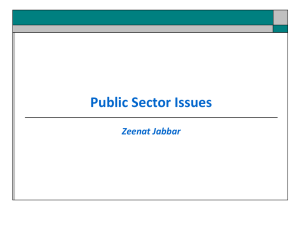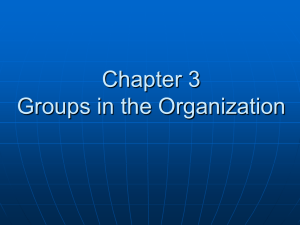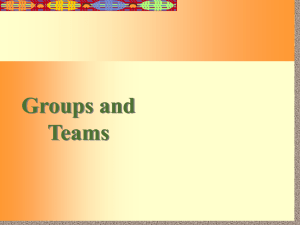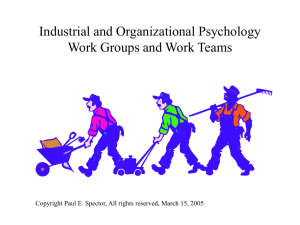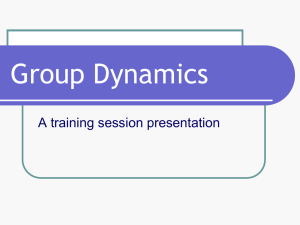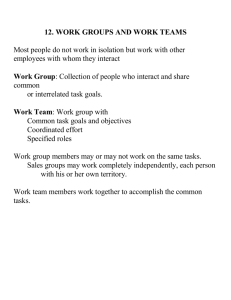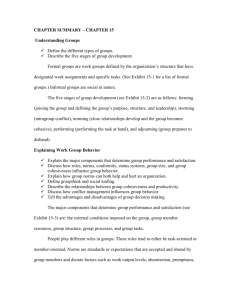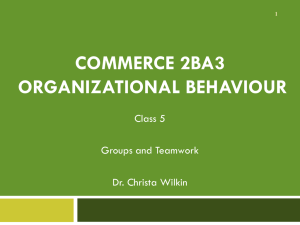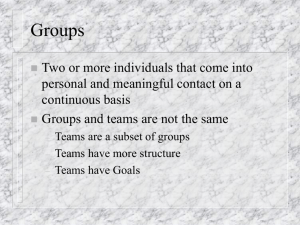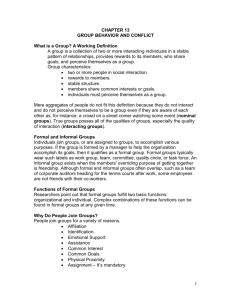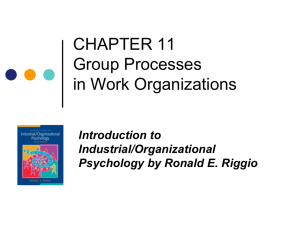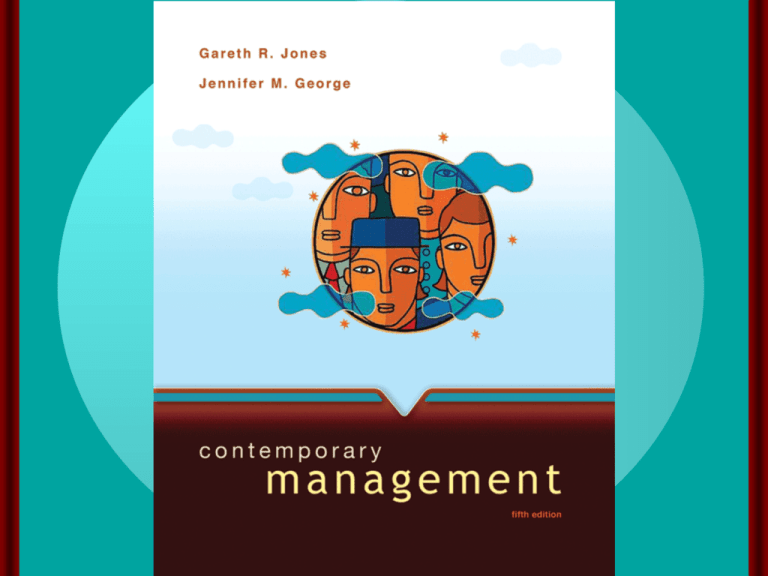
chapter fifteen
Effective Groups and Teams
McGraw-Hill/Irwin
Contemporary Management, 5/e
Copyright © 2008 The McGraw-Hill Companies, Inc. All rights reserved.
Learning Objectives
• Explain why groups and teams are key
contributors to organizational
effectiveness.
• Identify the different types of groups and
teams that help managers and
organizations achieve their goals.
• Explain how different elements of group
dynamics influence the functioning and
effectiveness of groups and teams.
15-3
Learning Objectives
• Explain why it is important for groups
and teams to have a balance of
conformity and deviance and a moderate
level of cohesiveness.
• Describe how managers can motivate
group members to achieve
organizational goals and reduce social
loafing in groups and teams.
15-4
Groups, Teams and
Organizational Effectiveness
• Group
– Two or more people
who interact with
each other to
accomplish certain
goals or meet certain
needs.
15-5
Groups, Teams and
Organizational Effectiveness
• Team
– A group whose members work intensely
with each other to achieve a specific,
common goal or objective.
– All teams are groups but not all groups are
teams.
• Teams often are difficult to form.
• It takes time for members to learn how to
work together.
15-6
Groups, Teams and
Organizational Effectiveness
• Two characteristics distinguish teams
from groups
– Intensity with which team members work
together
– Presence of a specific, overriding team goal
or objective
15-7
Groups and Teams as
Performance Enhancers
• Advantage of synergy
– People working in a group are able to
produce more outputs than would have
been produced if each person had worked
separately
15-8
Groups and Teams as
Performance Enhancers
• Factors that contribute to synergy
– Ability of group members to bounce ideas
off one another
– To correct one another’s mistakes
– To bring a diverse knowledge base to bear
on a problem
– To accomplish work that is too vast for any
one individual to achieve
15-9
Groups and Teams as
Performance Enhancers
• To take advantage of the potential for
synergy, managers need to make sure
groups are composed of members who
have complementary
skills and knowledge
relevant to the
group’s work
15-10
Groups’ and Teams’ Contributions to
Organizational Effectiveness
Figure 15.1
15-11
Groups and Teams and
Responsiveness to Customers
• Responsiveness to Customers
– Difficult to achieve given the many
constraints.
• Safety issues, regulations, costs.
– Cross-functional teams can provide the wide
variety of skills needed to meet customer
demands.
• Teams consist of members of different
departments.
15-12
Teams and Innovation
• Innovation
– The creative development of new products,
new technologies, new services, or new
organizational structures
• Individuals rarely possess the wide variety of
skills needed for successful innovation.
• Team members can uncover each other’s flaws
and balance each other’s strengths and
weaknesses
• Managers should empower the team and make it
accountable for the innovation process.
15-13
Groups and Teams as Motivators
• Members of groups, and particularly
teams, are often better motivated and
satisfied than individuals.
– Team members are more motivated and
satisfied than if they were working alone.
– Team members can see the effect of their
contribution to achieving team and
organizational goals.
– Teams provide needed social interaction and
help employees cope with work-related
stressors.
15-14
The Types of Groups and Teams in
Organizations
Figure 15.2
15-15
The Types of Groups and Teams
• Formal Group
– A group that managers establish to
achieve organization goals.
15-16
Formal Groups
• Cross-functional teams
– composed of members from different
departments
• Cross-cultural teams
– composed of members from different
cultures or countries
15-17
The Types of Groups and Teams
• Informal Group
– A group that managers or nonmanagerial
employees form to help achieve their own
goals or to meet their own needs.
15-18
The Types of Groups and Teams
Type of Team
Top-management
team
A group composed of the CEO, the president,
and the heads of the most important
departments
Research and
development team
A team whose members have the expertise
and experience needed to develop new
products
Command groups
A group composed of subordinates who
report to the same supervisor, also called a
department or unit,
Task forces
A committee of managers or nonmanagerial
employees from various departments or
divisions who meet to solve a specific,
mutual problem; also called an “ad hoc”
committee
15-19
The Types of Groups and Teams
Type of Team
Self-managed work
team
A group of employees who supervise their
own activities and monitor the quality of the
goods and services they provide.
Virtual team
A team whose members rarely or never meet
face to face and interact by using various
forms of information technology such as
email, computer networks, telephone, fax and
video conferences.
Friendship group
An informal group composed of employees
who enjoy each other’s company and
socialize with each other.
Interest group
An informal group composed of employees
seeking to achieve a common goal related to
their membership in an organization.
15-20
Self-Managed Work Teams
Keys to effective self managed teams:
– Give the team enough responsibility and
autonomy to be self-managing.
– The team’s task should be complex enough
to include many different steps.
– Select members carefully for their diversity,
skills, and enthusiasm.
– Managers should guide and coach, not
supervise.
– Determine training needs and be sure it is
provided.
15-21
Virtual Teams
• A team whose members rarely meet
face-to-face
• Interact by using various forms of
information technology
• Email, computer networks, telephone,
fax, and videoconferences
15-22
Friendship Groups
An informal group composed of employees
who enjoy one another’s company and
socialize with
one another
15-23
Interest Groups
An informal group of employees seeking to
achieve a common goal related to their
membership in an organization
15-24
Group Size
• Advantage of small groups
– Interact more with each other and easier to
coordinate their efforts
– More motivated, satisfied, and committed
– Easier to share information
– Better able to see the importance of their
personal contributions
15-25
Group Size
• Advantages of large groups
– More resources at their disposal to achieve
group goals
– Enables managers to obtain division of
labor advantages
15-26
Group Size
• Disadvantages of large groups
– Problem of communication and coordination
– Lower level of motivation
– Members might not think their efforts are
really needed
15-27
Group Tasks
• Group tasks impact how a group
interacts.
– Task interdependence shows how the work
of one member impacts another; as
interdependence rises, members must work
more closely together.
15-28
Group Dynamics: Interdependence
• Pooled
– Members make separate, independent
contributions to group such that group
performance is the sum of each member’s
contributions
15-29
Group Dynamics: Interdependence
• Sequential
– Members perform tasks in a sequential
order making it difficult to determine
individual performance since one member
depends on another.
15-30
Group Dynamics: Interdependence
• Reciprocal
– Work performed by one group member is
mutually dependent on work done by other
members.
15-31
Types of Task Interdependence
Figure 15.3
15-32
Group Roles
• Group Roles
– The set of behaviors and tasks that a group
member is expected to perform because of
his or her position in the group.
15-33
Group Roles
• In cross-functional teams, members are
expected to perform roles in their specialty.
• Managers should clearly describe expected
roles to group members when they are
assigned to the group.
• Role-making occurs as workers take on more
responsibility in their roles as group members.
• Self-managed teams may assign the roles to
members themselves.
15-34
Group Leadership
• Effective leadership is a key ingredient in high
performing groups, teams, and organizations.
• Formal groups created by an organization
have a leader appointed by the organization.
• Groups that evolve independently in an
organization have an informal leader
recognized by the group.
15-35
The Stages of Group Development
Figure 15.4
15-36
Stages of Group Development
• Forming
– Group members get to know each other and
reach common goals.
• Storming
– Group members disagree on direction and
leadership. Managers need to be sure the
conflict stays focused.
• Norming
– Close ties and consensus begin to develop
between group members.
15-37
Stages of Group Development
• Performing
– The group begins to do its real work.
• Adjourning
– Only for task forces that are temporary.
– Note that these steps take time!
15-38
Group Norms
• Group Norms
– Shared guidelines or rules for behavior that
most group members follow
– Managers should encourage members to
develop norms that contribute to group
performance and the attainment of group
goals
15-39
Group Dynamics
• Conformity and Deviance
– Members conform to norms to obtain rewards,
imitate respected members, and because they
feel the behavior is right.
– When a member deviates, other members will
try to make them conform, expel the member,
or change the group norms to accommodate
them.
– Conformity and deviance must be balanced for
high performance from the group.
– Deviance allows for new ideas in the group.
15-40
Balancing Conformity and
Deviance in Groups
Figure 15.5
15-41
Group Cohesiveness
• The degree to which members are
attracted to their group
• Three major consequences
– Level of participation
– Level of conformity to group norms
– Emphasis on group goal accomplishment
15-42
Sources and Consequences of
Group Cohesiveness
Figure 15.6
15-43
Factors Leading to Group
Cohesiveness
Factor
Group Size
Smaller groups allow for high cohesiveness;
Low cohesiveness groups with many
members can benefit from splitting into two
groups.
Managed Diversity
Diverse groups often come up with better
solutions.
Group Identity
Encouraging a group to adopt a unique
identity and engage in competition with
others can increase cohesiveness.
Success
Cohesiveness increases with success;
finding ways for a group to have some small
successes increases cohesiveness.
15-44
Managing Groups and Teams
for High Performance
• Motivating group members to achieve
organizational goals:
– Members should benefit when the group
performs well—rewards can be monetary or
in other forms such as special recognition.
– Individual compensation is a combination of
both individual and group performance.
– Make additional resources (beyond
compensation) such as choice assignments
available to high-performance groups.
15-45
Managing Groups and Teams
for High Performance
• Social loafing
– The human tendency to put forth less effort
in a group than individually.
– Results in possibly lower group performance
and failure to
attain group
goals
15-46
Managing Groups and Teams
for High Performance
• Reducing social loafing:
– Make individual efforts identifiable and
accountable.
– Emphasize the valuable contributions of
individual members.
– Keep group size at an appropriate level.
15-47
Three Ways to Reduce Social Loafing
Figure 15.7
15-48

